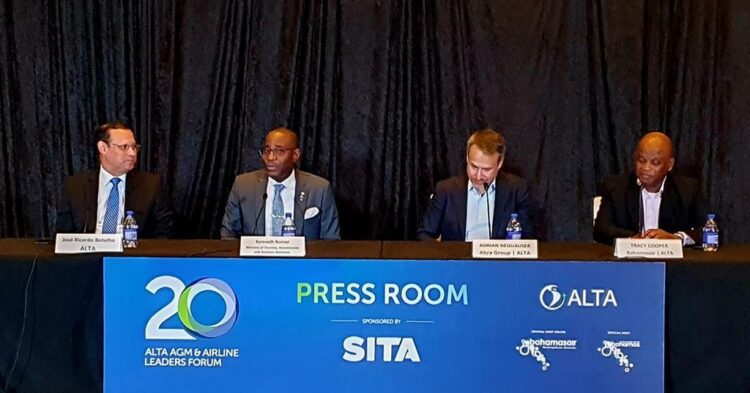Latin American and Caribbean airline leaders have arrived in the Bahamas for their annual meeting, hoping to use the 20th edition of the ALTA AGM and Leaders’ Forum to highlight the industry’s needs in a region that promises massive growth potential.
At ALTA’s opening press conference on 28 October, the industry organisation’s leaders acknowledged that progress towards a more stable and prosperous aviation industry has been made on numerous fronts. But, they say, with aviation as such an essential requirement for connectivity across the region, goverments still need work harder to create the conditions for the industry not just to survive, but to thrive.
“This kind of event like the ALTA leaders forum aims to bring us together once a year, to bring the people together, to show that we are walking the talk, and how can we manage the challenges that we have in our region,” says ALTA chief executive Jose Ricardo Botelho.
Those perennial challenges include a patchwork of rule frameworks, over-regulation and high taxation, which in some countries threatens to choke the growth of air travel. Connectivity both between the numerous Caribbean island nations as well between those states and the South American mainland is also top of mind for leaders – some of whom had to take circuitous journeys to get to Nassau arrive for the event.
STRENGTH IN NUMBERS
ALTA is expecting 400 attendees at this year’s event which is being held in the Caribbean region for the first time in nine years, The Bahamas, an archipelago of 700 islands located about 300km (160nm) southeast of the US mainland, is a prime example of a place where this kind of connectivity is desperately needed. The government recognises that, and its state-owned carrier is doing its best to work within its possibilities.
For the government of the Bahamas, “air connectivity continues to feature prominently in our agenda,” says Kenneth Romer, the aviation director in the Bahamian ministry of tourism, investments and aviation.
Tracy Cooper, chief executive of the national flag carrier Bahamasair, adds that he is counting on the support of his ALTA colleagues to help bring attention to some of the issues facing the islands.
“We need conferences and colleagues [with whom] we can work together because when you have small carriers like ourselves, we fell like we are part of something that is much larger to help fight some of the battles,” like regulation, he says. “We may not be a big enough [airline] to fight those things ourselves, so being under the ALTA umbrella helps us to get the backing of the bigger boys that have muscle in those areas.”
Cooper told FlightGlobal last month that Bahamasair is actively pursuing interline connections to expand its reach across the region, and allow travellers to more seamlessly connect to the islands. But the air transport industry in the Bahamas – analogue to tourism – is seasonal, and almost 80% of the country’s visitors come from North America. Therefore, the airline has to be very strategic as it plans for the future.
SEEKING STABILITY
“What we do as an industry is pretty incredible,” says Adrian Neuhauser, ALTA executive committee president and chief executive officer of Latin American airline holding company Abra. “We bring people together, we power economies and drive businesses and allow cultures to mix and mingle, we drive recreation.”
“It’s amazing what we do every day. We put people in aluminium tubes that go almost at the speed of sound, miles up in the air and we make it seem so normal,” he adds. “Yet, we are still an industry that faces complex regulation and complex taxation, changing rules, we work with very, very thin margins, with difficult capital structures.”
Because aviation is so capital-intensive, the companies are desperate for stability, something that has been in short supply in some parts of Latin America. In addition, South American airlines are still finding their feet following the catastrophic Covid-19 pandemic, during which many were left largely to flounder on their own without any government aid.
“You need regulatory certainty,” Neuhauser says. “We make investments for the long term, so what you are seeing now – we are making the small changes that we can make, for example in smaller gauge planes or frequencies. But in terms of longer commitment, we need the longer-term rules to be stable.
“None of us have overcome the losses of the pandemic,” he adds. ”Many of us are generating positive cash flows, but recovering the losses that were generated during the pandemic will take a long tim
“It’s an interesting region in the sense that because we are a poor region, the airlines were left to fend for themselves. The airlines needed to sort them selves out. The vast majority of us were able to do that but we still have significant losses.”
Source link : http://www.bing.com/news/apiclick.aspx?ref=FexRss&aid=&tid=671ffce8e57f47339d6de5a25ab3e419&url=https%3A%2F%2Fwww.flightglobal.com%2Fairlines%2Flatin-american-and-caribbean-airlines-leaders-gather-to-talk-connectivity-and-regulation%2F160490.article&c=9565019816591327454&mkt=en-us
Author :
Publish date : 2024-10-28 09:24:00
Copyright for syndicated content belongs to the linked Source.
